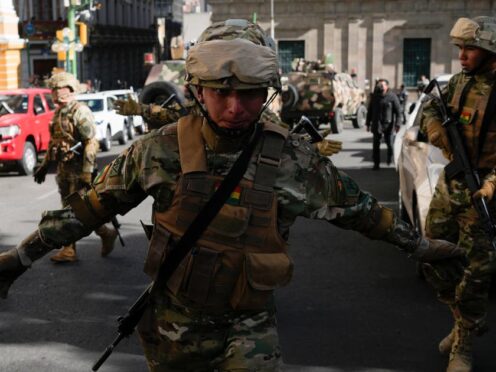
Armoured vehicles rammed into the doors of Bolivia’s government palace on Wednesday as President Luis Arce said the country faced an attempted coup and urged people to mobilise.
In a video of Mr Arce surrounded by ministers in the palace, he said: “The country is facing an attempted coup d’etat. Here we are, firm in Casa Grande, to confront any coup attempt. We need the Bolivian people to organise.”
Mr Arce confronted the general commander of the Army — Juan Jose Zuniga, who appeared to be leading the rebellion — in the palace hallway, as shown on video on Bolivian television.
“I am your captain, and I order you to withdraw your soldiers, and I will not allow this insubordination,” Mr Arce said.

Before entering the government building, Mr Zuniga told journalists in the plaza: “Surely soon there will be a new Cabinet of ministers; our country, our state cannot go on like this.”
Mr Zuniga said that “for now” he recognises Mr Arce as commander in chief.
Mr Zuniga did not explicitly say he is leading a coup, but in the palace, with bangs echoing behind him, he said the army was trying to “restore democracy and free our political prisoners”.
In a message on his X account, Mr Arce called for “democracy to be respected”.
It came as Bolivian television showed two tanks and a number of men in military uniform in front of the government palace in La Paz.
“We cannot allow, once again, coup attempts to take the lives of Bolivians,” he said from inside the palace, surrounded by government officials, in a video message sent to news outlets.

An hour later, Mr Arce announced new heads of the army, navy and air force amid the roar of supporters.
Video showed troops setting up blockades outside the government palace.
He said the troops who rose against him were “staining the uniform” of the military and vowed that democracy would be respected.
“I order all that are mobilised to return to their units, said the newly named army chief Jose Wilson Sanchez.
“No-one wants the images we’re seeing in the streets.”
Soon after troops and armoured vehicles start pulling back from Bolivia’s presidential palace.
The leadership of Bolivia’s largest labour union condemned the action and declared an indefinite strike of social and labour organisations in La Paz in defence of the government.
Former president Evo Morales, also in a message on X, denounced the movement of the military in the Murillo square outside the palace, calling it a coup “in the making”.
María Nela Prada, minister of the presidency and a top Bolivian official, called it an “attempted coup d’etat”.
“The people are on alert to defend democracy,” she said to local television station Red Uno.
The incident was met with a wave of outrage by other regional leaders, including the Organisation of American States; Gabriel Boric, the president of neighbouring Chile; the leader of Honduras, and former Bolivian leaders.
Bolivia, a country of 12 million people, has seen intensifying protests in recent months over the economy’s precipitous decline from one of the continent’s fastest-growing two decades ago to one of its most crisis-stricken.
The country also has seen a high-profile rift at the highest levels of the governing party. Mr Arce and his one-time ally, leftist icon and former President Morales, have been battling for the future of Bolivia’s splintering Movement for Socialism, known by its Spanish acronym MAS, ahead of elections in 2025.

Enjoy the convenience of having The Sunday Post delivered as a digital ePaper straight to your smartphone, tablet or computer.
Subscribe for only £5.49 a month and enjoy all the benefits of the printed paper as a digital replica.
Subscribe